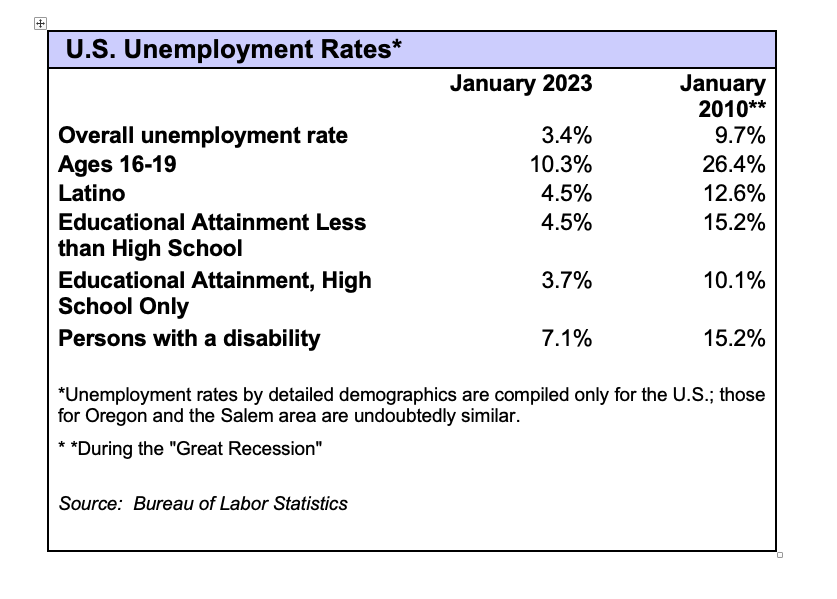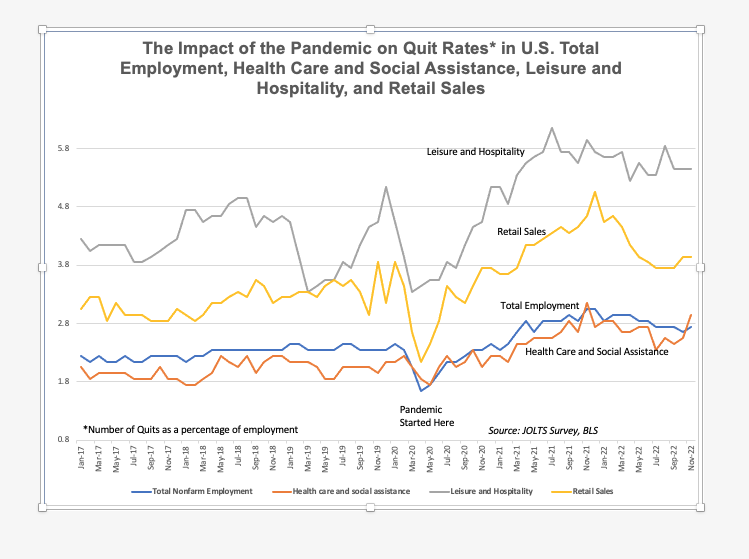Workers and job seekers at the lower end of the pay scale are earning higher wages and have more job choices now than before the pandemic, in Salem, the state and the U.S.
Why is this the case? The explanation has to do with the unique nature of what happened to the economy over the pandemic’s course.
Recall that 90 percent of the 26,000 jobs lost in the Salem area in the first months of the pandemic were low-wage jobs mostly in service industries. Hardest hit was the leisure and hospitality industry, which lost half its employment in one month. The categories of retail sales and health care and social assistance also lost substantial numbers of workers early on.
This was truly unique. Layoffs in the Great Recession (beginning in 2008) were evenly split between service workers and goods-producing workers (such as construction and manufacturing).
As the pandemic progressed, some laid-off workers went to work in other industries. As pandemic restrictions eased and hiring ramped up again, there was a huge demand for workers in lower-wage service jobs.
Then a basic law of economics came into play.
When demand for something increases, the price of that something goes up – in this case, labor to fill lower-wage service jobs. Sure enough, employers had to raise wages to attract applicants.
There’s plenty of evidence that this happened.
First, overall wages in Marion County increased from 2021 to 2022 by nearly 1% after accounting for inflation, according to the Oregon Employment Department’s wage records.
However, substantially larger wage gains went to workers in industries with the lowest wages, in leisure and hospitality (a 4.6% gain) and retail sales (3.2%). Workers in health care and social assistance, an industry with a median wage on the lower side, experienced a 2.8% wage gain.
This translates into 52,000 Salem area workers – nearly a third of total employment – receiving substantial pay raises over the year, the result of increased demand for their labor.
Another place to look for evidence of increasing wages at the lower end of the wage scale is in the Employment Department’s most recent job vacancy survey. According to the fall 2022 survey, employers reported an average starting hourly wage of $24.12, a 5.5% increase from the year before.
Even more startling was that there was a 47% decrease from the year prior in the share of wages starting at less than $15 an hour.
Additional evidence of pay raises for low-wage workers comes from the economists of the Federal Reserve Bank of Dallas. These researchers analyzed pay raises by income quintile. Before the pandemic, all five income levels gained pay increases at about the same rate. During the pandemic, the lowest income quintile experienced wage gains nearly twice as large as those at the top.
One way to get a pay raise is to quit a low-paying job for a better-paying one. There’s evidence that this happened extensively during the pandemic.
The Job Openings and Labor Turnover Survey of the federal Bureau of Labor Statistics compiles “quit rates” – which is the number of quits as a percentage of employment – every month. During the pandemic, quit rates increased, and dramatically so in several industries:
•Quit rates in overall U.S. employment increased as the pandemic wore on.
•Quit rates in the Health Care and Social Assistance industry increased during the pandemic.
•Quit rates in the leisure and hospitality industry and in retail sales rose much more dramatically than did overall rates.
Although the above analysis is for the U.S. as a whole, it undoubtedly applies to Oregon and the Salem area as well.
Oregon Employment Department economist Damon Runberg analyzed what happened to restaurant and hotel workers when they lost or quit their jobs during the pandemic.
Employment Department wage records were used to track workers over periods of equal length for first pre-pandemic and then during the first two years of the pandemic. Not surprisingly, more restaurant and hotel workers left their jobs during the pandemic than pre-pandemic.
And more than a quarter of them found jobs in other industries, a slightly higher share than prior to the pandemic.
A surprising finding was that the same share of these workers “dropped out” of the labor force during the pandemic as in the period prior. Runberg concluded, “This puts to rest the theory that there was an increasing share of labor force dropouts” during the pandemic.
The bottom line is that restaurant and motel jobs are difficult, stressful, and low paying, and job turnover is the norm. However, there was more turnover than usual as the pandemic progressed, and many workers in these occupations were able to find other jobs.
Last but not least, the low unemployment rate has helped job seekers who have had difficulty finding jobs in times of high unemployment.

Jacqueline Osborne, manager of DPI Staffing’s Salem area branch, connects job seekers who have employment barriers to suitable positions with employers. Osborne said the tight labor market is helping her job seekers. Osborne comments that many employers are trying to be as inclusive as possible in their hiring decisions, and that’s helping too.
Patricia Callihan-Bowman, owner of ExpressPros staffing agency in Salem, has 33 years of experience in the business. Callihan-Bowman said, “Considering the last couple of years, employees are re-evaluating their work-life balance and priorities. People are more willing to change jobs to increase their job satisfaction now with so many companies needing people.”
It is difficult to predict how long the competition for workers will last. But it’s likely that job seekers with employment barriers will be seeing good job prospects and workers will continue to be able to change jobs to increase their job satisfaction for a while longer.
A recession has yet to appear, unemployment rates are still low, and the economy is adding jobs monthly at a good pace, in the Salem area, Oregon, and the U.S.
Only time will tell when this picture might change.
Pamela Ferrara of the Willamette Workforce Partnership continues a regular column examining local economic issues. She may be contacted at [email protected].
CORRECTION: The unemployment rate for persons with a disability in January 2023 was 7.1%. An earlier version of the unemployment chart contained the wrong figure. Salem Reporter apologizes for the error.
SUBSCRIBE TO GET SALEM NEWS – We report on your community with care and depth, fairness and accuracy. Get local news that matters to you. Subscribe today to get our daily newsletters and more. Click I want to subscribe!

Pamela Ferrara is a part-time research associate with the Willamette Workforce Partnership, the area’s local workforce board. Ferrara has worked in research at the Oregon Employment Department, earned a Master’s in Labor Economics, and speaks fluent Spanish.









